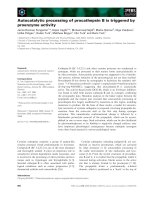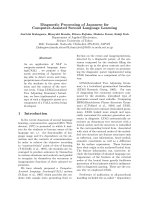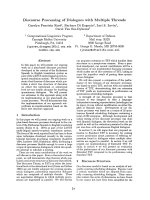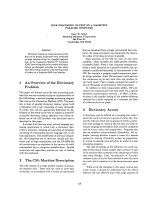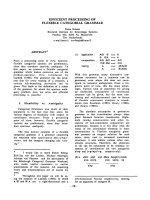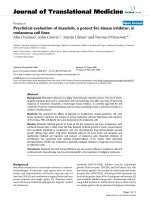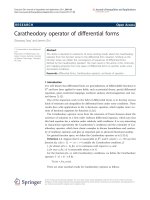Báo cáo hóa học: " Signal Processing of Ground Penetrating Radar Using Spectral Estimation Techniques to Estimate the Position of Buried Targets" pot
Bạn đang xem bản rút gọn của tài liệu. Xem và tải ngay bản đầy đủ của tài liệu tại đây (3.54 MB, 12 trang )
EURASIP Journal on Applied Signal Processing 2003:12, 1198–1209
c
2003 Hindawi Publishing Corporation
Signal Processing of Ground Penetrating Radar Using
Spectral Estimation Techniques to Estimate
the Position of Buried Targets
Shanker Man Shrestha
Arai Laboratory, Electronic Engineering Department, The University of Electro-Communications,
1-5-1 Chofugaoka, Chofu, Tokyo 182-8585, Japan
Email:
Ikuo Arai
Arai Laboratory, Electronic Engineering Department, The University of Electro-Communications,
1-5-1 Chofugaoka, Chofu, Tokyo 182-8585, Japan
Email:
Received 29 March 2003 and in revised form 28 June 2003
Super-resolution is very important for the signal processing of GPR (ground penetration radar) to resolve closely buried targets.
However, it is not easy to get high resolution as GPR signals are very weak and enveloped by the noise. The MUSIC (multiple signal
classification) algorithm, which is well known for its super-resolution capacity, has been implemented for signal and image pro-
cessing of GPR. In addition, conventional spectral estimation technique, FFT (fast Fourier transform), has also been implemented
for high-precision receiving signal level. In this paper, we propose CPM (combined processing method), which combines time
domain response of MUSIC algorithm and conventional IFFT (inverse fast Fourier transform) to obtain a super-resolution and
high-precision signal level. In order to support the proposal, detailed simulation was performed analyzing SNR (signal-to-noise
ratio). Moreover, a field exper iment at a research field and a laboratory experiment at the University of Electro-Communications,
Tokyo, were also performed for thorough investigation and supported the proposed method. All the simulation and experimental
results are presented.
Keywords and phrases: FFT, GPR, MUSIC algorithm, SFCW radar, super-resolution sign al processing.
1. INTRODUCTION
Spectral estimation techniques have been approved as a
unique tool for signal and image processing of radar. There
are different spectral estimation techniques, in which con-
ventional fast Fourier transform (FFT) has been widely used
for real-time measurement due to higher-computational effi-
ciency and its ability to produce high-precision receiving sig-
nal level for a large class of signal processes. However, there
are several inherent performance limitations of the inverse
fast Fourier transform (IFFT ) a pproach like low-frequency
range, that is, its ability to distinguish the spectral response
of two or more signals is very low, and implicit windowing
of the data, that is, energy of the main lobe of a spectral re-
sponse leaks into the side lobes.
Generally, ground penetration radar (GPR) is a narrow
bandwidth device and its radar range is normally high, a
wide bandwidth is greatly desired to enclose all t arget images,
which is difficult to make because it is limited by antenna size
in the low-frequency range and underground propagation
characteristics in the high-frequency range [1, 2]. In order
to overcome these problems, improvement of frequency res-
olution is greatly desired. Moreover, improvement of resolu-
tion is very important for GPR to trace out closely buried tar-
gets, like gas pipes, water pipes, cables, and so forth, in an ur-
ban area and also to detect the buried land mines that cause
thousands of human life every year throughout the world
[3, 4]. Therefore, we implemented super-resolution spectral
estimation technique multiple signal classification (MUSIC)
algorithm to improve the resolution capacity. Also, we imple-
mented conventional FFT to obtain the high-precision signal
level.
Several algorithms for super-resolution spectral estima-
tion have been proposed, for example, maximum likelihood
method (MLM) [5], minimum entropy method (MEM) [6],
estimation of signal parameter via rotational invariance tech-
nique (ESPRIT) [7], MUSIC [8], and so forth. In this pa-
per, the MUSIC algorithm, proposed by Schmidt [8], which
Signal Processing of GPR Using Spectr al Estimation Techniques 1199
Target
R. Ant.
Surface
T. Ant.
ResultCPM
MUSIC
Radar
signal
RF in
Network analyzer
RF out
Time-domain signal
IFFT
Frequency-domain signal
Personal computer
Signal output
Figure 1: Simple block diagram of radar system and proposed signal processing technique.
requires preprocessing to decorrelation is used as a reference.
Schmidt’s approach y i elds high resolution even if the signals
are partially correlated but does not cover the decorrelation
technique. Later, several authors have come up with suc-
cessful approaches to decorrelate the coherent signal. Nev-
ertheless, spatial smoothing process (SSP), which is based
on the spatial averaging technique, proposed by Evans [9]
andlaterpresentedwithmorecompleteanalysisbyShan
[10], has gained wide popularity. Further, a modified form
of SSP (MSSP) has been proposed by Williams [11]. We im-
plemented both SSP and MSSP preprocessing techniques for
simulation and experimental data processing.
The remainder of this paper is arranged in the follow-
ing manner. Signal and image processing methodology and
necessary formulation are presented in Section 2. Proposal of
CPM (combined processing method) and simulation results
are presented in Section 3. Field experiment and laborator y
experiment results as well as their performance analysis are
presented in Sections 4 and 5, respectively. Finally, we con-
clude this paper in Section 6.
2. METHODOLOGY AND FORMULATION
This research deals with a signal processing method used to
increase the vertical resolution of a radar image and to ob-
tain a high-precision signal level. Generally, there are two
types of GPRs, pulsed radar and FMCW (frequency modu-
lation continuous wave) radar [12]. Pulsed radar operates in
the time domain whereas FMCW radar operates in frequency
domain. The pulsed radar generates the pulse with a wide fre-
quency spectrum and performs sampling at successive pulse
to obtain the signal wave form. In contrast, FMCW radar
produces a sinusoidal wave that sweeps through a predefined
frequency band and measures the return signal strength at
different frequencies to obtain the frequency spectrum of the
target return. Therefore, frequency-domain signal can be di-
rectly measured from the FMCW radar. Most GPR are in
the time domain using the pulse signal, and sensitivity and
maximal detectable depth are usually limited by the antenna.
Recently,moreFMCWGPRsareemergingduetolargerdy-
namic range, less power consumption, and more convenient
calibration. In this research work, we used a vector network
analyzer as a GPR, which is based on an SFCW (step fre-
quency continuous wave) radar. This SFCW radar operates
in the frequency domain and is almost similar to the FMCW
radar except that the frequency changes in steps. The vec-
tor network analyzer transmits the frequency-domain com-
plex signal which has real and imaginary parts and received
the complex-reflected signal at different frequencies. This re-
flected frequency-domain data is considered as a radar signal
[13]. The data acquisition and the signal processing methods,
and experiment methodology are shown in Figure 1 and the
procedures are explained as follows.
(1) The frequency-domain radar signal spectrum is re-
ceived and it undergoes IFFT processing to obtain a
high-precision receiving signal level.
(2) The same frequency-domain radar signal undergoes
MUSIC processing to obtain high time-delay resolu-
tion.
(3) Time-domain responses are obtained in both cases.
The time-domain responses of IFFT and MUSIC are
combined, in a process we call CPM.
(4) A simulation was carried out to verify the proposed
method. The signal-to-noise ratio (SNR) was analyzed
to investigate the efficiency and the robustness of the
proposed method.
(5) A field experiment was performed to support the sim-
ulation and to obtain a real image of the buried targets
in a soil medium.
(6) A lab experiment was performed to investigate the
maximum resolution capacit y that can be detected by
the proposed method in a water medium.
The objective of this research is to apply the proposed
method for the signal processing and image reconstruction
of GPR.
1200 EURASIP Journal on Applied Signal Processing
2.1. MUSIC algorithm
The MUSIC algorithm is a nonparametr ic spectral estima-
tion technique, which estimates multiple scattering centers
from the observed voltage received on an array of antenna
utilizing the eigenvector. The eigenvectors can be used to
compute a spectrum with DOA (direction of arrival) [14, 15,
16] and estimate delay time of high-frequency spect rum [8].
The eigenvalue of diagonal matrix helps to estimate the num-
bers of reflected signals.
The measured value of reflected signal from the target
with a vector network analyzer can be expressed using vec-
tor notation as follows:
x = Ay + w, (1)
where
x
∼
=
x
1
,x
2
, ,x
L
T
,
A
∼
=
a
τ
1
, a
τ
2
, ,a
τ
L
,
a
τ
K
∼
=
e
−j2πf
1
τ
L
,e
−j2πf
2
τ
L
, ,e
−j2πf
k
τ
L
T
,
y
∼
=
y
1
,y
2
, ,y
L
T
,
w
∼
=
w
1
,w
2
, ,w
L
T
.
(2)
Here, T represents transpose. Again a(τ)vectorcanbede-
clared by its time, so it is cal led a mode vector. The symbol
A is a delay parameter matrix which has L numbers of ar-
rays and the kth element of row. So, L canberegardedasthe
number of signals while the symbol y is the reflection coef-
ficient of the Lth reflection point at frequency f
k
and w is a
noise vector. The LL signal covariance matrix of x vector is
represented by
S = xx
∗
= (Ay + w)(Ay + w)
∗
, (3)
where
∗ denotes complex conjugate transpose. Also, arriv-
ing wave and internal noise can be considered as not related
(orthogonal), and the signal covariance matrix becomes
S
∼
=
APA
∗
+ σ
2
I. (4)
Here, the elements of the noise vector w are mean zero and
σ
2
is the variance.
The position (delay time) of each reflection point can be
estimated by searching the peak position of the MUSIC func-
tion (P
music
)
P
music
(τ) =
a(τ)
∗
a(τ)
a(τ)
∗
E
N
E
∗
N
a(τ)
, (5)
where a(τ) is a delay-time mode vector and E
N
is the noise
L(L − k) matrix whose columns are the (L − k)noiseeigen-
vector.
2.2. Smoothing process
GPR signals are generally coherent signals as the measure-
ments was taken by SFCW radar based on vector network
x
M
x
3
x
2
x
1
f
1
f
2
f
3
f
N
f
N+1
f
L−1
f
L
x
L
x
L−1
x
N+1
x
N
x
3
x
2
x
1
Figure 2: Frequency-domain subarray arrangement.
analyzer. The vector network analyzer generates the identical
signal, and the phase and the amplitude of the reflected sig-
nals also do not change from snapshot to a nother. MUSIC
fails to work properly when the signals are coherent. So, a
decorrelation process is performed in order to eliminate the
problems encountered with coherent signals. The received
signal is divided into the numbers of overlapping subarrays
or snapshots as shown in Figure 2. Consequently, the phase
is changed in each snapshot. Two smoothing methods have
been proposed so far, SSP and MSSP.
2.2.1. Spatial smoothing process (SSP)
We consider the frequency-domain array with L reflection
coefficient that extends from (1, 2, 3, ,N,N +1, ,L
−
1,L), making M number of overlapping snapshots having
length N, as shown in Figure 2. The relation between L, M,
and N can be formulated as
L
= N + M − 1. (6)
Let x
1
be the first snapshot having length N and x
2
the second
snapshot and extending up to x
M
overlapping snapshot. The
phase changes in each snapshot. We have the Lth element of
subarray in our model equation, so it can be written as
x
k
= AD
(k−1)
y + w
k
, (7)
where D
k
denotes the kxk diagonal matrix, represented as
D
= diag
e
−j2π∆ fτ
1
,e
−j2π∆ fτ
2
, ,e
−j2π∆ fτ
k
, (8)
where ∆ f is the sampling frequency separation.
Signal Processing of GPR Using Spectr al Estimation Techniques 1201
Table 1: Parameter setting for simulation.
Center frequency 85 MHz
Q factor 1
Frequency bandwidth 125
Number of signals 3
Delay separation of each sig nal 20 ns
Sampling frequency 1 MHz
The covariance matrix of the kth subarray is g iven by
S
k
= x
k
x
∗
k
, (9)
S
k
=
AD
(k−1)
yy
∗
D
(k−1)
∗
A
∗
+ σ
2
I. (10)
The spatially smoothed covariance matrix is defined as the
sample means of the subarray covariance and is expressed as
S
SSP
=
1
M
M
k=1
S
k
. (11)
2.2.2. Modified spatial smoothing process (MSSP)
In MSSP, the covariance matrix is expressed as
S
k
= JS
∗
k
J, (12)
where J denotes an N ×N exchange matrix and is formulated
as follows
J =
00··· 01
00··· 10
.
.
.
.
.
.
···
.
.
.
.
.
.
01··· 00
10··· 00
. (13)
Equation (10)isequivalentto
S
k
=
JAD
(k−1)
yy
∗
D
(k−1)
∗
A
∗
J
+ σ
2
I. (14)
Here,
JA = AD
(N−1)
,
S
k
= AD
(N+k−2)
yy
∗
D
(N+k−2)
∗
A
∗
+ σ
2
I.
(15)
Performing spatial averaging, MSSP can be expressed as
S
MSSP
=
1
2M
M
k=1
S
k
+ JS
k
J
. (16)
In MSSP, when the effective band is reduced from L to
N, the resolution will be reduced; nevertheless, the resolu-
tion is far better than with IFFT. In other words, if M is in-
creased, N will be decreased because L = N + M − 1. Con-
sequently, decorrelation performance is increased and reso-
lution is decreased. On the other hand, if M is decreased, N
will be increased, which means that the effective bandwidth
will be increased and the resolution will also be increased but
the decorrelation performance will be degraded. The min-
imum value M gives range profiles of high resolution but
some dominant scattering center may not be detected due to
the degradation of decorrelation performance and vice versa
[17]. Therefore, M should be adjusted according to the na-
ture of target recognition.
3. SIMULATION
We generate a radar signal using a bandpass filter (BPF)
which can be expressed by
H( f )
=
j
ω
◦
/Q
ω
ω
2
◦
− ω
2
+ j
ω
◦
/Q
ω
, (17)
where ω = 2πf, Q = 1, and f
0
= 85 MHz. Parameters for
the simulation are shown in Table 1.
The BPF generates complex frequency-domain data hav-
ing real and imaginary information. This frequency-domain
spectrum of radar data, shown in Figure 3a, undergoes IFFT
processing. In the mean time, the same radar signal under-
goes MUSIC processing and the results are comparatively
studied [18, 19]. The frequency-domain data is converted
into the time-domain data in both cases. Let the complex
IFFT results in the time domain be represented by X(t)and
the MUSIC results Y(t). The time-domain results of IFFT
and MUSIC are combined using the CPM, which is calcu-
lated using the following expression:
Z(t) =
X|∂Y/∂t| + Y |∂X/∂t|
|∂Y/∂t|
2
+ |∂X/∂t|
2
, (18)
where Z(t) is the time-domain data of CPM.
In order to explain (18), mathematical analysis has been
performed. Since combining the time-domain responses of
IFFT and MUSIC are performed by calculating the slope
and the position of the signal, the delay of the IFFT re-
sponse signal and MUSIC response signal should be coin-
cided, which is a required condition. So, in this particular
condition, when we consider the point at the peak (centre) of
the curve (Figure 3b), the slope of MUSIC will be very higher
than the slope of IFFT due to sharp response of MUSIC. This
can be expressed mathematically by
∂Y
∂t
∂X
∂t
so that
∂X
∂t
≥ 0. (19)
Substituting the value of ∂X/∂t in (18)gives
Z(t) = X. (20)
Equation (20) means that the signal level of Z(t)willbe
the amplitude of the IFFT. Similarly, when we consider the
point drifted f rom the peak (center) of the curve (Figure 3b),
1202 EURASIP Journal on Applied Signal Processing
Frequency (MHz)
0 20 40 60 80 100 120
Power spectrum (dB)
−30
−25
−20
−15
−10
−5
0
5
10
(a) Frequency spectrum of radar signal.
Time (ns)
0 20 40 60 80 100 120 140
Amplitude
0
0.2
0.4
0.6
0.8
1
Third target
Second target
First target
CPM
IFFT
MUSIC
(b) IFFT, MUSIC, and CPM responses.
Time (ns)
0 20 40 60 80 100 120 140
Amplitude
0
0.2
0.4
0.6
0.8
1
Third target
Second target
First target
CPM
IFFT
MUSIC
(c) Demonstration of CPM response to resolve the close targets.
Figure 3: Simulation result to demonstrate the IFFT, MUSIC, and
CPM responses at bandwidth = 125 MHz, Q = 1, sampling point
= 125, sampling frequency = 1 MHz, number of snapshots (M)
= 222.
Time (ns)
0 20 40 60 80 100 120 140
Amplitude
0
0.2
0.4
0.6
0.8
1
1.2
1.4
CPM
IFFT
MUSIC
(a) IFFT, MUSIC, and CPM responses of signal only.
Time (ns)
0 20 40 60 80 100 120 140
Amplitude
0
0.2
0.4
0.6
0.8
1
1.2
1.4
CPM
IFFT
MUSIC
(b) IFFT, MUSIC, and CPM responses of noise only.
Time (ns)
0 20 40 60 80 100 120 140
Amplitude
0
0.2
0.4
0.6
0.8
1
1.2
1.4
CPM
IFFT
MUSIC
(c) IFFT, MUSIC, and CPM responses of signal plus noise.
Figure 4: Simulation results of input SNR −5.8dBand M = 30.
(a) IFFT, MUSIC, and CPM responses of signal only. (b) IFFT, MU-
SIC, and CPM responses of noise only. (c) IFFT, MUSIC, and CPM
responses of signal plus noise.
Signal Processing of GPR Using Spectr al Estimation Techniques 1203
the slope of IFFT response curve is very higher than MU-
SIC response curve. It can also be expressed mathematically
by
∂X
∂t
∂Y
∂t
so that
∂Y
∂t
≥ 0. (21)
Substituting the value of ∂X/∂t in (18)gives
Z(t) = Y. (22)
Equation (22) means that the signal le vel of Z(t)willbethe
amplitude of the MUSIC. Therefore, it is found that Z(t)se-
lects the precision signal level of X (IFFT response) when the
slope of X is low and also selects the signal level of Y (MUSIC
response) when the slope of Y is low.
It is observed in Figure 3b that the IFFT response gives
correct amplitude. The amplitude of the second sig nal was
set to the half of the first signal and the third signal was set
to one-fourth of the first signal. The response of the IFFT
changed according to the value set. However, resolution is
very poor and also suffers from a windowing problem. In
MUSIC response, the output signal is very sharp and the res-
olution is ver y high as it is estimated from the peak of the
MUSIC function. However, the precision of receiving signal
level is low. CPM response gives high resolution as well as
a high-precision signal level. In this context, high resolution
means the maximum resolving capacity between the verti-
cally aligned targets. In Figure 3c, the IFFT could not resolve
two closely located targets well, that is, the delay-time dif-
ference between the successive signal is 10 nanoseconds. On
the other hand, MUSIC could resolve the same two closely
located targets well but the precision of signal level is low.
However, the proposed method CPM could well resolve two
closely located targets with high-precision signal level that is
demonstrated in Figure 3c.
3.1. SNR analysis
Generally, subsurface radar signals are enveloped by noise
when targets are deeply buried. The SNR will be very s mall
because the radar signal decay is caused by both wave spread-
ing and soil absorption, as the wave propagates through the
soil. Improvement of SNR is desired to allow a minimum
detectable signal to be obtained when investigating deep
targets. Practically, minimum detectable signal is based on
threshold level which should be set properly, otherwise false
alarm might result if the threshold level was set too low, and
weak target echo might not be detected if the threshold level
was set too high. Therefore, SNR of input signal and each
IFFT, MUSIC, and CPM responses have been calculated and
analyzed in order to set proper threshold level.
While calculating input SNR, the total energy of the sig-
nal and noise is separately summed because the input sig nal
and noise is frequency-domain spectrum. The SNR is given
by
SNR
input
= 10 log
∞
0
F
s
( f )
2
df
∞
0
F
n
( f )
2
df
. (23)
Third target
Second target
0.5m
2m
First target
Depth
1.5m
1.0m
0.5m
Surface
6m4m2m
Figure 5: Target position at the experiment field. The target is a
steel pipe having diameter of 10 cm.
All the simulations have been performed using Matlab.
Noise is generated by a random noise generator function.
In order to calculate the output SNR of IFFT response, the
IFFT processing has been performed with signal only. Con-
sequently, the time-domain response of signal will be ob-
tained, in which amplitude is measured from zero to peak
(V
0–p
). Similarly, IFFT is performed with only noise, that is,
generated by a random noise generator. As a result, time-
domain response is obtained; however, in case of noise, RMS
(root mean square) value of all the points of IFFT response
should be calculated. SNR of IFFT response of noise is given
by
SNR
output
= 20 log
V
0–p
(1/n)
n
i=0
N
t
i
2
. (24)
Similarly, SNR of MUSIC and CPM responses are calcu-
lated as with IFFT. However, the number of snapshots M was
changed while processed by MUSIC to investigate the effect
of M with respect to SNR. Simulation results are shown in
Figure 4. Input SNR was
−5.8 dB, the number of overlapping
snapshots M was 30, frequency bandwidth was 250 MHz,
sampling points was 250, sampling frequency was 1 MHz.
The comparison is difficult due to great discrepancies ob-
served in the amplitude of IFFT and MUSIC responses. So,
MUSIC response has been normalized with IFFT response
according to its maximum value of signal level.
In Ta bl e 2, the simulation results have been presented
varying input SNR. It was found that the minimum de-
tectable signal is −15.2 dB. The SNR response of IFFT, MU-
SIC, and CPM at this input SNR has been a chie ved 35.1 dB,
11.3 dB, and 10.4 dB, respectively. In this case, SNR of IFFT
response exhibited superior performance over SNR of MU-
SIC response. It is observed from the simulation results that
M plays an important role in the improvement of SNR and
that M varies for smoothing while performing MUSIC pro-
cessing. When M is increased, SNR will also be improved but
resolution will be decreased. On the other hand, decrease in
M degrades SNR but increases resolution [17]. This can be
1204 EURASIP Journal on Applied Signal Processing
Table 2: Simulation results to investigate the SNR.
Input SNR (dB) SNR of IFFT response (dB) No. of snapshots (M) SNR of MUSIC response (dB) SNR of CPM response (dB)
−15.2 35.1 30 11.3 10.4
− 5.8 45.75 30 13.6 11.1
− 5.6 45.3 235 41.5 39.8
− 5.0 45.9 100 32.1 23.6
− 6.4 46.0 75 25.2 19.8
− 4.9 49.5 50 14.2 13.4
− 4.5 50.3 30 11.5 11.7
− 2.5 53.1 30 11.9 10.5
+2.2 57.4 30 12.6 11.8
+7.7 63.1 30 12.9 12.0
Table 3: Parameter setting for field experiment.
Frequency bandwidth 400 MHz (1–401) MHz
Frequency interval 1MHz
No. of points 401
Soil conductivity 0.02 S/m
Soil permittivity ε
r
36
Target diameter 10 cm
Vertical target separation 50 cm
illustrated by the simulation result shown in Table 2 . When
M is set to 30, SNR of MUSIC responses is 13.6 dB at in-
put SNR −5.8dB and when M is increased to 100 SNR of
MUSIC, the response increases up to 32.1 dB at input SNR
−5.0 dB. It is to be noted that the SNR of CPM is also in-
creased up to 23.6 dB due to the effect of MUSIC. Thus, in-
creasing the value of M can increase SNR.
4. FIELD EXPERIMENT
A field experiment was performed at the research field of Ko-
den Elec tronics Company, Yamanashi, Japan, using Network
analyzer that has a capability of measuring high-precision
data. This vector network analyzer works as an SFCW radar.
The experimental field is ordinary soil, a grass landscape with
steel pipes buried under the earth at the horizontal separa-
tion of about 2 m and vertical separation of 50 cm, as shown
in Figure 5. Parameters for the field experiment are shown in
Table 3.
Different sets of experimental data were taken at an incre-
ment of 10 cm to scan the target using ferrite covered bow-
tie antenna. Frequency-domain data was used to perform
IFFT and MUSIC processing simultaneously. Then CPM
processing method was performed combining time-domain
response of IFFT and MUSIC processing as in simulation
process. The comparative study of IFFT, MUSIC, and CPM
processing results are shown in Figure 6, when the radar an-
tenna is just above the 1 m depth target. The first signal is
the coupling signal between radar antenna and ground. The
second signal is target signal.
Two-dimension (2D) and three-dimension (3D) im-
ages of IFFT, MUSIC, and CPM are presented in a linear
scale, shown in Figure 7. Image of IFFT processing result
(Figure 7a)isclearandhavecontinuousdiffraction pattern
due to the precision receiving signal level. However, resolu-
tion could not be considered high, and the impact of win-
dowing and presence of noise could not be ignored. On the
other hand, the image of MUSIC processing is sharp and
resolution is ver y high, which is shown in Figure 7c.More-
over, time-side lobe is also significantly eliminated. MUSIC
uses eigenanalysis and the number of eigenvalue helps to es-
timate the number of signal with high resolution. Generally,
the eigenvalue below the noise level could be discarded. Eige-
nanalysis can be performed varying the value of M (snap-
shot) and L (array element) as explained before in theoreti-
cal considerations. Different approaches have been taken to
approximate the value of M and L during simulation and
experimental data processing as they play a vital role in ob-
taining good results. In this result (Figure 7c), the value of
M is set to 10 and L is set to 50, the resulting value of N
(snapshot length) is set to 41, which is obtained using (6).
The frequency range utilized for MUSIC processing is from
150 MHz to 350 MHz.
Finally, the image of CPM processing result in Figure 7e
shows that the resolution has been greatly improved from
Figure 7a, and the continuity of target image has also been
improved from Figure 7c. 3D representation of CPM, shown
in Figure 7d, gives clear vision of the targets and shows that
the CPM could successfully extr act the merits of IFFT and
MUSIC algorithm, such as a very high resolution and a very
high-precision receiving signal level.
5. LABORATORY EXPERIMENT
The encouraging responses with the high resolution and
the high-proximity images of the target buried under the
Signal Processing of GPR Using Spectr al Estimation Techniques 1205
Frequency (MHz)
0 50 100 150 200 250 300 350 400
Power spectrum (dB)
−60
−50
−40
−30
−20
−10
(a) Frequency-domain spectrum of radar signal measured by a
vector network analyzer.
Time (ns)
010 20 30405060
Amplitude
0
0.2
0.4
0.6
0.8
1
1.2
1.4
CPM
IFFT
MUSIC
Coupling signal
First target signal
(b) IFFT, MUSIC, and CPM responses of radar data.
Figure 6: Experimental result to demonstrate the IFFT, MUSIC,
and CPM responses at bandwidth = 400 MHz, sampling point
= 400, sampling frequency 1 MHz.
soil medium have been demonstrated by the field experi-
ment. Since this research is concentrated to resolve the verti-
cal resolution, further investigation was performed to check
the maximum resolution capacity between two vertically
aligned targets. For this, experimental setup in the water
medium has been developed in the University of Electro-
Communications laboratory with an aquarium of length
40 cm, breadth 40 cm, and height 100 cm. Two targets of cop-
per pipe of 38 cm long were fixed at the 10 cm depth from the
water surface with a vertical separation of 2 cm and horizon-
tal separation of 4 cm as shown in Figure 8.
The experimental setup includes the high-bandwidth an-
tenna, network analyzer, and the signal processing unit. A
Table 4: Parameter setting for laboratory experiment.
Frequency band 800 MHz (500–1300) MHz
No. of points 801
Sweep time 1 s
Small change in frequency 1 MHz
Water relative permittivity ε
r
81
Target diameter 1 cm
Vertical target separation 2 cm
register loaded dipole antenna was used for the experiment.
The antenna bandwidth is 600 MHz (500 to 1100 MHz) and
the antenna size was 4 × 6 cm. Parameter settings in the net-
work analyzer for experimental purposes are as shown in
Table 4.
The antenna is submersed in the water; however, water
level and top surface of the antenna is kept at the same level.
Antenna is moved from left to right at the increment of 1 cm
to scan the target as shown in Figure 8.Different sets of ex-
periment were per formed with varying the diameter, mate-
rial, and the position of the target. Diameter ranges from
1 cm to 2.5 cm and material used are aluminum and copper.
The vertical target separation ranges from 1 to 10 cm and the
horizontal separation ranges from 0 to 10 cm. These various
sets of data have been taken to investigate the magnitude of
reflected sig nal, shadowing effect, and measurements of ver-
tical resolution.
When the diameter of the target is 2.5 cm, the magnitude
of the receiving signal is fairly good compared to the target
having 1 cm, however, the shadowing effect (the shadow of
the upper target) is high when the second target was just be-
low the first one. Similarly, the target at the depth ranging
from 10 to 20 cm results the good receiving signal and in-
creasing target depth will decrease the signal level.
The comparative study of IFFT, M USIC, and CPM
processing results of laboratory experiment are shown in
Figure 9, when the radar antenna is just above the first
target. The images of laboratory experimental results are
shown in Figure 10. Two-dimension imaging of IFFT, MU-
SIC, and CPM responses are presented in Figures 10a, 10c,
and 10e, respectively. Three-dimension imaging of the same
IFFT, MUSIC, and CPM responses are presented in Fig-
ures 10b, 10d,and10f, respectively. All the images are
represented in linear scale, and interpolation process has
not been performed as in the field experiment as the fre-
quency bandwidth is higher. Kaiser filter was imposed in
raw data while performing IFFT processing. MSSP was im-
plemented for MUSIC processing w h ich yield better image
than SSP method because of the wide frequency bandwidth
data.
The main objective of this experiment is to check the
maximum detectable vertical resolution of the proposed
method. So, this experiment has been performed with two
targets, which are set at the vertical separation of 2 cm. Two-
dimension and three-dimension images of IFFT response
1206 EURASIP Journal on Applied Signal Processing
Horizontal distance (m)
01234567
Time (ns)
80
60
40
20
0
−10
−5
0
5
10
(a) 2D representation of IFFT processing.
Horizontal distance (m)
0
1
2
3
4
5
6
7
Time (ns)
80
60
40
20
0
0
5
10
Amplitude
(b) 3D representation of IFFT processing.
Horizontal distance (m)
0123456 7
Time (ns)
80
60
40
20
0
−10
−5
0
5
10
(c) 2D representation of MUSIC processing.
Horizontal distance (m)
0
1
2
3
4
5
6
7
Time (ns)
80
60
40
20
0
0
5
10
15
20
Amplitude
(d) 3D representation of MUSIC processing.
Horizontal distance (m)
01234567
Time (ns)
80
60
40
20
0
−10
−5
0
5
10
(e) 2D representation of CPM processing.
Horizontal distance (m)
0
1
2
3
4
5
6
7
Time (ns)
80
60
40
20
0
0
10
20
30
40
Amplitude
Third target
Second target
First target
(f) 3D representation of CPM processing.
Figure 7: 2D and 3D representations of IFFT, MUSIC, and CPM processing of field experiment data w i th bandwidth = 400 MHz, M = 10,
and L = 50.
Signal Processing of GPR Using Spectr al Estimation Techniques 1207
40 cm
40 cm
100 cm
4cm
Second target
2cm
First target
10 cm
Antenna
Figure 8: Experiment setup prepared in laboratory using aquarium
to do experiment in water medium to check maximum detectable
resolution.
Time (ns)
0 5 10 15 20
Amplitude
0
0.2
0.4
0.6
0.8
1
1.2
1.4
CPM
IFFT
MUSIC
Coupling signal
First target signal
Figure 9:IFFT,MUSIC,andCPMresponsesoflaboratoryexperi-
ment data.
show that the two targets could not be separ ated by this
IFFT processing. If we investigate in an analytic manner,
the maximum vertical resolution that can be calculated by
FFT is
∆r
=
c
2B
√
ε
r
, (25)
where ∆r is the vertical resolution between two targets, c is
the velocity of light, B is the frequency bandwidth, and ε
r
is
the relative permittivity of the medium.
In this experiment, (frequency bandwidth) B is set to
800 MHz and (relative permittivity of the water) ε
r
is set to
81. Theoretically, IFFT response can resolve a maximum ver-
tical resolution of 2.1 cm in a noise-free environment. Prac-
tically, this could not be achieved due to the presence of
noise, leakage of main lobe energy into side lobe, and so
forth. This is the very reason that IFFT processing could
not resolve the target with the vertical separation of 2 cm.
The time-resolution problem could not be overcome in IFFT
processing as can be observed in the 3D imaging of IFFT,
shown in Figure 10b . On the other hand, 2D MUSIC re-
sponse could successfully resolve two or more targets dis-
tinctly due to its super-resolution characteristic. 3D pre-
sentation in Figure 10d shows a very slim target response
without a time-side lobe; however, the continuity of sig-
nal could not be maintained. The CPM response, as shown
in Figure 10e, yields remarkable high-resolution reduction
of time-side lobe and continuous scattering pattern of sig-
nal has been achieved. 3D representation of CPM shown in
Figure 10f gives clear vision of the targets.
6. CONCLUSIONS
The time-domain response of IFFT and MUSIC have been
combined to obtain super-resolution and high-precision re-
ceiving signal level. The proposed CPM could successfully
resolve vertically separated targets up to 2 cm at 800 MHz
frequency bandwidth in water medium, as shown in labo-
ratory experiment. The field experiment and laboratory ex-
periment results show the remarkable reduction of time-side
lobes and natural clutter. Moreover, CPM could successfully
demonstrate the continuous scattering pattern of the radar
signal that is realized from 2D and 3D images of both lab-
oratory and field experiment. From the simulation results,
it is concluded that CPM has higher resolution than other
conventional signal processing methods due to the effect of
MUSIC and also the precision of receiving signal level is high
due to the effect of IFFT. Further, the SNR analysis results
show that the proposed method is robust from the point
of view of noise if the value of M is increased during the
smoothing process. These are the major achievement of this
research work. The proposed method could be practically
implemented to detect closely buried water pipes, gas pipes,
cables, and even antipersonnel and antitank land mines.
ACKNOWLEDGMENTS
The authors would like to thank the Koden-Electronics Com-
pany, Yamanashi Prefecture, Japan, for providing its research
field for experimental purpose. We would like to thank Dr.
Kazuo Yamamoto at Electronic Navigation Research Institute
(ENRI), Tokyo, Prof. Christian Pichot at LEAT, University of
Nice-Sophia, France, and Mr. Michael Cashen at the Univer-
sity of Electro-Communications, Tokyo, for their suggestions
and support. The authors would like to thank the reviewers
for providing comments and suggestions, which have greatly
improved the pap er.
1208 EURASIP Journal on Applied Signal Processing
Horizontal distance (cm)
51015202530
Time (ns)
180
160
140
120
100
80
60
40
20
−5
0
5
10
15
20
×10
−5
(a) 2D representation of IFFT processing.
Horizontal distance (cm)
0
10
20
30
Time (ns)
200
150
100
50
0
0
2
4
Amplitude
×10
−4
−5
0
5
10
15
20
×10
−5
(b) 3D representation of IFFT processing.
Horizontal distance (cm)
510152025 30
Time (ns)
180
160
140
120
100
80
60
40
20
−5
0
5
10
15
20
(c) 2D representation of MUSIC processing.
Horizontal distance (cm)
0
10
20
30
Time (ns)
200
150
100
50
0
0
20
40
Amplitude
−5
0
5
10
15
20
(d) 3D representation of MUSIC processing.
Horizontal distance (cm)
51015202530
Time (ns)
180
160
140
120
100
80
60
40
20
−5
0
5
10
15
20
×10
−5
(e) 2D representation of CPM processing.
Horizontal distance (cm)
0
10
20
30
Time (ns)
200
150
100
50
0
0
2
4
Amplitude
×10
−4
−5
0
5
10
15
20
×10
−5
First target
Second target
(f) 3D representation of CPM processing.
Figure 10: 2D and 3D representations of IFFT, MUSIC, and CPM processing of laboratory experiment data with bandwidth = 800 MHz,
M = 30, and L = 150.
Signal Processing of GPR Using Spectr al Estimation Techniques 1209
REFERENCES
[1] I. Arai, Y. Tomizawa, and M. Hirose, “Pulse compression sub-
surface radar,” IEICE Transactions on Communications,vol.
E83-B, no. 9, pp. 1930–1937, 2000.
[2] Y. Tomizawa and I. Arai, “Subsurface radar using a coded sig-
nal without time-sidelobes,” Journal of Remote Sensing Society
of Japan, vol. 21, no. 5, pp. 423–430, 2001.
[3] W. R. Scott Jr., J. S. Martin, and G. D. Larison, “Experimental
model for a seismic landmine detection system,” IEEE Trans-
actions on Geoscience and Remote Sensing,vol.39,no.6,pp.
1155–1164, 2001.
[4] J. I. Halman, K. A. Shubert, and G. T. Ruck, “SAR processing
of ground-penetrating radar data for buried UXO detection:
results from a surface-based system,” IEEE Trans. Antennas
and Propagation, vol. 46, no. 7, pp. 1023–1027, 1998.
[5] J. Capon, “High resolution frequency-wave number spectrum
analysis,” Proc. IEEE, vol. 57, pp. 1408–1418, August 1969.
[6] A. Yoshizawa and T. Iwasaki, “Image reconstruction in opti-
cal frequency-domain reflectometry by means of maximum
entropy method—Fourier transform combination,” IEICE
Trans., vol. J76-C-I, no. 6, pp. 215–221, 1993.
[7] R. Roy and T. Kailath, “ESPRIT—Estimation of signal param-
eters via rotational invariance techniques,” IEEE Trans. Acous-
tics, Speech, and Signal Processing, vol. 37, no. 7, pp. 984–995,
1989.
[8] R. O. Schmidt, “Multiple emitter location and signal param-
eter estimation,” IEEE Trans. Antennas and Propagation,vol.
34, no. 3, pp. 276–280, 1986.
[9] J.F.Evans,J.R.Johnson,andD.F.Sun, “Applicationofad-
vanced signal processing techniques to angle of arrival esti-
mation in A.T.C. navigation and surveillance systems,” Tech.
Rep. 582, MIT Lincoln Lab, Lexington, Mass, USA, June 1982.
[10] T J. Shan, M. Wax, and T. Kailath, “On spatial smoothing
for direction-of-arrival estimation of coherent signals,” IEEE
Trans. Acoustics, Speech, and Signal Processing, vol. 33, no. 4,
pp. 806–811, 1985.
[11] R. T. Williams, S. Prasad, A. K. Mahalanabis, and L. H. Sibul,
“An improved spatial smoothing technique for bearing esti-
mation in a multipath environment,” IEEE Trans. Acoustics,
Speech, and Signal Processing, vol. 36, no. 4, pp. 425–432, 1988.
[12] M. I. Skolnik, Radar Handbook, McGraw-Hill, NY, USA, 2nd
edition, 1990.
[13] H. Yamada, M. Ohmiya, Y. Ogawa, and K. Itoh, “Superreso-
lution techniques for time-domain measurements with a net-
work analyzer,” IEEE Trans. Antennas and Propagation, vol.
39, no. 2, pp. 177–183, 1991.
[14] T. Akiyama, T. Yamaoka, and N. Hamada, “2-d direction-of-
arrival estimation using a linear interpolation technique for
circular array,” IEICE Transactions on Communications,vol.
E84-B, no. 9, pp. 215–221, 2001.
[15] J S. Jeong, K. Sakaguchi, K. Araki, and J. Takada, “General-
ization of MUSIC using extended ar ray mode vector for joint
estimation of instantaneous DOA and angular spread,” IEICE
Transactions on Communications, vol. E84-B, no. 7, pp. 1781–
1789, 2001.
[16] T. Yamakura, H. Yamada, and Y. Yamaguchi, “Resolution im-
provement of the MUSIC algorithm utilizing two differently
polarized antennas,” IEICE Transactions on Communications,
vol. E79-B, no. 12, pp. 1827–1832, 1996.
[17] K T. Kim, D K. Seo, and H T. Kim, “Efficient radar tar-
get recognition using the MUSIC algorithm and invariant fea-
tures,” IEEE Trans. Antennas and Propagation, vol. 50, no. 3,
pp. 325–337, 2002.
[18] S. M. Shrestha, I. Arai, and T. Miwa, “Signal processing of
ground penetrating radar combining FFT and MUSIC algo-
rithm for high resolution,” Tech. Rep. IEICE SANE2000,
SAT2000-130, Tokyo, Japan, 2001/2002.
[19] S. M. Shrestha, I. Arai, T. Miwa, and Y. Tomizawa, “Signal
processing of ground penetrating radar using super resolution
technique,” in IEEE Radar Conference, pp. 300–305, Atlanta,
Ga, USA, May 2001.
Shanker Man Shrestha received his B.S. de-
gree in electrical and electronic engineer-
ing from the Bangladesh University of En-
gineering and Technology (BUET), Dhaka
in 1993, and his M.E. degree in electronic
engineering from the University of Electro-
Communications (UEC), Tokyo, Japan in
2001. He is currently working towards the
Ph.D. degree at the UEC. From 1994 to
1998, he worked as a Communications En-
gineer in Transmission Planning, and Satellite Communication De-
partment, Nepal Telecommunications Corporations (NTC), Kath-
mandu, Nepal. From 1998 to 1999, he was a research student
at the UEC, Tokyo, Japan. His research interests include super-
resolution signal processing algorithm, ground penetrating radar
(GPR), FMCW radar, SAR (synthetic aperture radar), mobile and
satellite communications, and so on. His recent research activities
include the development of GPR for the land mine detection, ap-
plication of MUSIC algorithm in GPR, millimeter wave radar to
detect the helicopter obstacles. He is a student member of the IEEE,
IEICE, and Remote Sensing Society of Japan.
Ikuo Arai was born in Tochigi Prefecture,
Japan in 1941. He received his B.S. and
M.S. degrees from the University of Electro-
Communications, Tokyo, Japan in 1965 and
1967, respectively, and his Ph.D. degree in
electrical engineering from the University
of Tokyo in 1986. Since his graduation, he
has been working as a faculty member at
the University of Electro-Communications,
Tokyo, Japan. Currently, he is a Professor in
the Department of Electronics Engineering. He has been work-
ing in ground penetrating radar for 25 years. He is the Author
and Coauthor of several papers and books. His research interests
include medical electronics, ground penetr ating radar, and high-
resolution radar. He is a member of the Remote Sensing Society of
Japan, IEICE, and Archaeological Prospection Society of Japan.
